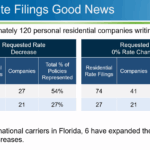Commercial drone flights are taking off in other countries while the U.S. lags behind in developing safety regulations that would permit unmanned aircraft operations by a wide array of industries, witnesses told a House panel this week.
The Federal Aviation Administration bars all commercial use of drones except for 13 companies that have been granted permits for limited operations. Permits for four of those companies were announced Wednesday, an hour before a hearing of the House Transportation and Infrastructure Committee’s aviation subcommittee. The four companies plan to use drones for aerial surveillance, construction site monitoring and oil rig flare stack inspections. The agency has received 167 requests for exemptions from commercial operators.
Several European countries have granted commercial permits to more than a 1,000 drone operators for safety inspections of infrastructure, such as railroad tracks, or to support commercial agriculture, Gerald Dillingham of the Government Accountability Office testified. Australia has issued more than 180 permits to businesses engaged in aerial surveying, photography and other work, but limits the permits to drones weighing less than 5 pounds. And small, unmanned helicopters have been used to monitor and spray crops in Japan for more than a decade.
Canada has had regulations governing the use of unmanned aircraft since 1996 and, as of September, had issued more than 1,000 permits this year alone, Dillingham said. Canada recently revised it regulations to grant blanket permission for flights of drones weighing less than 5 pounds and imposed certain restrictions on the operation of drones weighing between about 5 pounds and 55 pounds.
The Future of Drones in the Insurance Industry
The FAA has been working for years on developing safety rules to give small drones broader access to U.S. skies and agency officials have said they expect to propose regulations before the end of this month. But it could be at least two or three years before regulations become final, Dillingham said.
“It … concerns me that road builders in Germany and farmers in France today are enjoying economic benefits from (drones) because safety regulators there have found ways to permit such flights,” said the subcommittee’s chairman, Rep. Frank LoBiondo, R-N.J. “I can’t help but wonder if the Germans, French and Canadians can do some of these things today, then why can’t we also be doing them?”
Drone Use Takes Off Despite Safety Concerns, Restrictions
The U.S. has lead the world in the development of drones, but FAA regulations are so restrictive that researchers trying to resolve key technology gaps in order to make commercial unmanned aircraft safer are at a disadvantage compared to colleagues in some other countries, said Nicholas Roy, a Massachusetts Institute of Technology professor who has worked with Google on drone technology.
Even testing of drones in remote, unpopulated areas entails complying with onerous regulations in the U.S., while countries like the United Kingdom and Australia make allowances for flights in lightly populated areas, he said.
While U.S. researchers into unmanned aircraft haven’t yet fallen behind, “there are issues and constraints that may allow other countries to overtake the U.S. both in developing the next generation of technology and in training the next generation of engineers,” Roy said.
Earlier this week Amazon, which wants to deploy drones to deliver small packages, said FAA testing restrictions were so burdensome that the company is looking to do its research in other countries.
Peggy Gilligan, the FAA’s associate administrator for safety, told the committee that delays in issuing regulations for small drones are “beyond what any of us think acceptable,” she but assured lawmakers they would see proposed regulations very soon.
In general, “we agree we need to speed this up a little bit,” she said.
FAA officials frequently point out that there are far more planes and other aircraft in U.S. skies than in the skies of any other country, making the safe integration of drones a significant challenge. The FAA is receiving about 25 reports a month from pilots and others of drones flying in the vicinity of planes and airports, raising concern about the potential for collisions.
Lee Moak, president of the Air Line Pilots Association, brought a DJI Phantom — one of the most popular small drones on the market — with him to the subcommittee witness table. He told lawmakers the drone was capable of flying from the House office building where the hearing was being held, across the Potomac River and into the flight path of a plane landing at Washington Reagan National Airport. It’s difficult for pilots to see small drones: They aren’t equipped with technology to warn pilots of their presence; and they aren’t visible on the radar screens of air traffic controllers, he said.
The permits announced Wednesday were granted to Trimble Navigation Limited, VDOS Global LLC, Clayco Inc. and Woolpert Inc., which received two permits. Previously the only permits the Federal Aviation Administrational Aviation had issued were to two oil companies in Alaska and five aerial photography companies associated with television and film production.
Related:
- Cyber Attacks, Drones Pose Threat to Plane Safety: Allianz
- Erie Insurance Seeks Approval for Drone Use
- Insurer USAA Seeks OK to Test Drones for Claims Service
- State Farm Seeks to Test Drone Use for Damage Response in Illinois
Topics USA Legislation Aviation Tech
Was this article valuable?
Here are more articles you may enjoy.


 Aflac Hit With Class Action Over Data Breach of Customer Info
Aflac Hit With Class Action Over Data Breach of Customer Info  Slide’s Exec Pay Leads to Questions About Florida Citizens’ Rate Model
Slide’s Exec Pay Leads to Questions About Florida Citizens’ Rate Model  General Mills Changing Nature Valley Labels After Lawsuit’s Herbicide Claim
General Mills Changing Nature Valley Labels After Lawsuit’s Herbicide Claim  ‘Generali’ Sign Atop Insurer’s Skyscraper Offices Collapses in Milan
‘Generali’ Sign Atop Insurer’s Skyscraper Offices Collapses in Milan 

